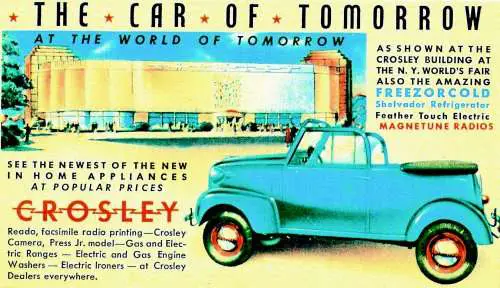Thursday 3rd July 1952
The last Crosley automobile was produced at their Marion factory in Indiana, US. Incorporated in 1939, Crosley Motors began assembling mini-cars in Richmond Indiana. The first Crosley was a two-door convertible. It weighed less than 1,000 pounds and sold for $250. In the beginning, his idea was for these small cars to be sold in department stores that also sold his radios and refrigerators: since the car was only 48 inches wide, it could be moved through a standard commercial store door. While there were some stores, such as Macy’s in New York, that displayed Crosley automobiles next to the Crosley refrigerators, the idea of selling cars in department stores did not really catch on. According to some reports, Mrs. Averell Harriman was the first Macy’s customer to buy a Crosley. The Crosley dealer network developed primarily as extensions of filling stations and automobile repair shops. In 1941, Crosley brought out some new body styles: both two- and four-door convertibles, a station wagon, a panel truck, a pickup, and a convertible sedan (this featured windows for the rear seat passengers). There was also the Parkway Delivery (a mini-panel truck with no roof over the front seat) and Covered Wagon (a convertible pickup truck with a removable back seat). With the top in place, the Covered Wagon functioned as a car and with the top down and the rear seat removed it became a ¼ ton pickup truck. A record-setting gas mileage run was made by Cannonball Baker in a Crosley Covered Wagon. He drove from Cincinnati to Los Angeles, then back through New Orleans, Jacksonville, and New York. The trip covered 6,517 miles and the Crosley averaged more than 50 miles per gallon. The Crosleys came equipped with a speedometer (60 mph maximum), ammeter, oil pressure gauge, and a hand-cranked windshield wiper. The windows slid open for ventilation and for signaling. In the summer, many Crosley owners simply removed the windows. The glove compartment was large enough for a pair of gloves, but little more. Prices for the 1941 models ranged from $315 for the 915 pound two-passenger convertible to $470 for the four-passenger station wagon which weighed 1160 pounds. At this time, the Cadillac Fleetwood sold for $2,195 and the Lincoln Continental convertible sold for $2,700. World War II brought gasoline rationing to the United States. With good gas mileage—50 mpg—the Crosley became an attractive vehicle. However, the war ended the production of all civilian automobiles in the United States, including the Crosley. Less than 6,000 prewar Crosleys were built. Following the war, Crosley car production resumed in 1946 with the new, larger, and aerodynamic CC model. At this time the public was car-hungry and ready to buy anything with an engine and four wheels. Initially, suppliers couldn’t provide nameplates for the cars and so Crosley had the name painted three inches high in red on the front and rear bumpers. The first post-war Crosleys were available only in grey with red seats. The speedometer now went to 70 mph and the glove compartment had been enlarged so that it could hold two pairs of gloves. In 1948, Crosley introduced the term “Sport Utility” with an open model based on a wagon. In 1948, Crosley introduced the first real postwar sports car in America: the HotShot. It sold for less than $1,000 and featured coil springs on the rear wheels and disc brakes on all four wheels. In 1950, Crosley brought out the Farm-O-Road model which was a small utility vehicle. The Farm-O-Road was designed: “To do big jobs on small farms, and smaller jobs on big farms.” The vehicle looked like a small Jeep and was intended for rural customers who wanted a vehicle for doing chores around the farm and which could take them into town as well. The base price was $795 and options included dual rear wheels, a pickup bed which could come with a hydraulic dump, power take-off on both front and rear, a rear seat, a top, and side window curtains. Attachments included such items as a 10-inch plow, a sickle bar mower, and a three-gang reel mower. Crosley’s best year was 1948 when 24,871 cars were sold. Sales began to slip in 1949. By 1951 production was down to 300 cars per month and in 1952 only 1,522 Crosley’s were sold at which time production stopped. There were plans to merge Crosley with Nash, but when Nash merged with Hudson that merger did not happen.






